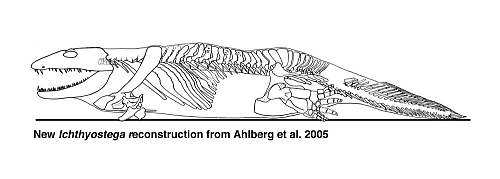Ichthyostega
The original 'four-legged' fish: the first Devonian tetrapod to be found
If a non-palaeontologist has heard of a Devonian tetrapod, it will probably be
Ichthyostega, the 'four-legged fish'. Our 1987
expedition had recovered
some excellent material from Stensiö Bjerg of this animal as well as Acanthostega,
which revealed its curious complement of seven toes on the hind limb.
However, many questions remain unanswered about its anatomy, body form, and environment. One of the main objectives of the 1998 expedition was to collect material that would try to answer some of these questions. For example, three papers have placed Ichthyostega and Acanthostega in their stratigraphical and sedimentological context (Blom et al. 2005, 2007; Larsen et al. 2009). Others have concentrated on the anatomy of Ichthyostega.
However, many questions remain unanswered about its anatomy, body form, and environment. One of the main objectives of the 1998 expedition was to collect material that would try to answer some of these questions. For example, three papers have placed Ichthyostega and Acanthostega in their stratigraphical and sedimentological context (Blom et al. 2005, 2007; Larsen et al. 2009). Others have concentrated on the anatomy of Ichthyostega.
Current Work
Our current study, funded by the Natural Environment Research Council, has aimed to
resolve some of the puzzles set by these early tetrapods. Using the latest computer
techniques, in collaboration with the
Royal Veterinary College, London, (see
Stephanie Pearce and John Hutchinson
in the Collaborators section), we have built a realistic
virtual 3-D model of the skeleton of Ichthyostega, to see how the bits
really did fit together. Thus we aimed to test the 2-D model from 2005 (see below).
Then we studied the potential mobility of the axial skeleton and limbs of both Acanthostega and Ichthyostega, and compared these with analagous modern tetrapods. Our work on the range of motion of the limbs of Ichthyostega was published earlier in 2012. We showed that Ichthyostega did not 'walk' in a conventional sense, but probably used its forelimbs in a mud-skipper like manner, with the hind limbs contributing stability but not power to the movement. The hind limbs were more likely to have been used in swimming. See Professor John Hutchinson's RVC web page about it.
Jenny and Stephanie were interviewed by Richard Hollingham for the NERC website Planet Earth Online and the result broadcast recently in their podcast at http://planetearth.nerc.ac.uk/multimedia/story.aspx?id=1369&cookieConsent=A.
We have also looked at Pederpes in our study, and our colleague Julia Molnar has been working on this.
Then we studied the potential mobility of the axial skeleton and limbs of both Acanthostega and Ichthyostega, and compared these with analagous modern tetrapods. Our work on the range of motion of the limbs of Ichthyostega was published earlier in 2012. We showed that Ichthyostega did not 'walk' in a conventional sense, but probably used its forelimbs in a mud-skipper like manner, with the hind limbs contributing stability but not power to the movement. The hind limbs were more likely to have been used in swimming. See Professor John Hutchinson's RVC web page about it.
Jenny and Stephanie were interviewed by Richard Hollingham for the NERC website Planet Earth Online and the result broadcast recently in their podcast at http://planetearth.nerc.ac.uk/multimedia/story.aspx?id=1369&cookieConsent=A.
We have also looked at Pederpes in our study, and our colleague Julia Molnar has been working on this.
Previous work
Although several reconstructions had been made of whole animal, of both its skeleton
and the 'living' animal, in fact, there were many problems with them. For one thing,
most of the articulated fossils showed either just a head and thorax or a tail, pelvis
and hind limb. None really showed how those two halves meshed together. The 1998
material included some that did. In 2000, then, we received the first of our grants
to work up this
material alongside the previously collected specimens. Major discoveries
resulted from these.
Braincase and Ear Region
Clack et al. (2003) showed that its braincase and ear region were unique,
and were probably adapted for underwater audition. Those parts of its anatomy had
previously been difficult to interpret, and earlier studies by Jarvik had effectively
opted out of trying to do so.
We used microCT scanning of our new material as well as fresh
preparation of original material to come to our conclusions. We also discovered that,
contrary to previous observations, Ichthyostega possessed ossified and grooved gill-bars,
like Acanthostega.
Skeletal Anatomy
Another study concentrated on the skeletal anatomy of Ichthyostega. Using mainly the
original material, we found that the axial skeleton showed many differences from previous
reconstructions: the tail was shorter, the shoulder girdle was larger and there were fewer
vertebrae in front of the sacrum. Most
surprisingly, the pre-sacral column showed distinct
regionization along its length, including neural spines whose orientation varied, and in
the immediate presacral region, they alternated in size and shape between broad and narrow
as seen in side view. We made an new reconstruction, published in 2005 (Ahlberg et al. 2005).
However, this was only a two-dimensional reconstruction: it remained to be tested in
three-dimensions. See above in Current Work.
The Humerus
Our 1998 material included sub-adult Ichthyostega
specimens, whose humeri showed distinct differences from those of the adult material from
the original collections. Some of these differences suggested that the sub-adults retained
more primitive and fish-like characters than the adults. The equivalent stages in
Acanthostega humeri did not show these differences. Secondly, both sub-adult and adult
humeri of Ichthyostega lacked several derived
characters that were shared by Acanthostega
and other, Carboniferous, early tetrapods. These findings argued against the general and
widely accepted idea that Acanthostega was the more primitive of the two taxa.
Phylogenetic
analysis was unable to resolve this conundrum unequivocally, and we concluded that there
must have been a lot more diversity among Devonian tetrapods, and probably several ways of
being a tetrapod with limbs during this period. This study was published in 2009 (Callier
et al. 2009).
